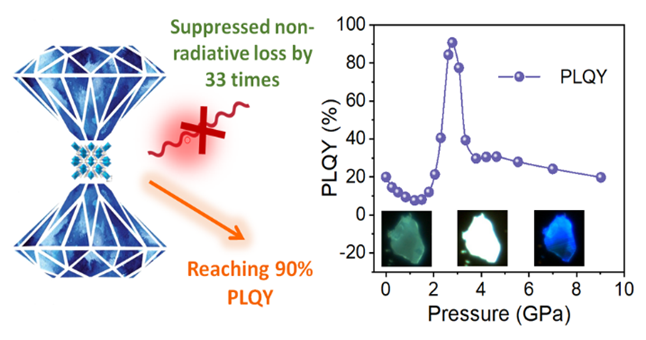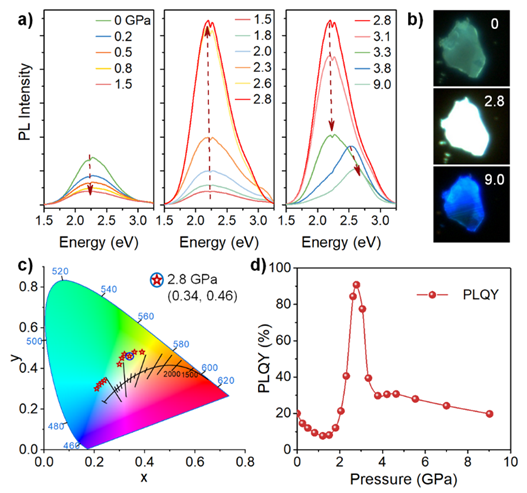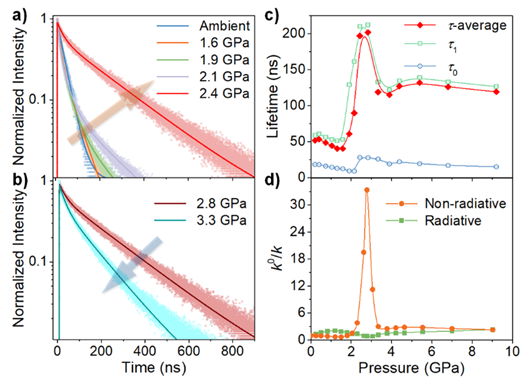Reaching 90% Photoluminescence Quantum Yield in 1D Metal Halide by Pressure-Suppressed Nonradiative Loss- Drs. Xujie Lü and Wenge Yang
SEPTEMBER 16, 2020
An international team led by Dr. Xujie Lü and Dr. Wenge Yang from the Center for High Pressure Science and Technology Advanced Research (HPSTAR) discovered that pressure can sufficiently suppress the non-radiative loss in 1D metal halide C4N2H14PbBr4, and lead to the photoluminescent quantum yield (PLQY) increasing from initial 20% to over 90% at 2.8 GPa (Figure 1). In-situ optical characterization and theoretical analysis revealed that the suppressed non-radiative loss is directly related to the pressure-tuned STE binding energy and confined motion of organic cations. Importantly, for the first time, PLQYs were quantitatively determined under gigapascal pressures. The findings were recently published in J. Am. Chem. Soc.

Figure 1. Suppressed nonradiative loss and enhanced PLQY of C4N2H14PbBr4 under pressure.
Low-dimensional perovskite-related metal halides have emerged as a new class of light-emitting materials with tunable broadband emission from self-trapped excitons (STEs). Although various types of low-dimensional structures have been developed, fundamental understating of the structure–property relationships for this class of materials is still very limited, and further improvement of their optical properties remains greatly important.
Pressure has been utilized as an effective and clean stimulus to regulate the structure and optoelectronic properties of various types of materials. The soft lattices of metal halides render them sensitive to pressure and lead to effective modifications under a mild pressure range. Despite exciting pressure-enhanced/induced emission results reported in hybrid metal halides, the microscopic origins are not fully understood yet. It is well-known that PL efficiency is highly dependent on the competition between radiative (kr) and nonradiative (knr) recombination rates. However, the influences of structural evolution on kr and knr, especially knr, have not been well elucidated.

Figure 2. Pressure-dependent PL of C4N2H14PbBr4 under 360 nm excitation. (a) In situ PL spectra at different pressures. (b) PL photographs at selected pressures: ambient (top), 2.8 GPa (middle), and 9.0 GPa (bottom). (c) Chromaticity coordinates of the emissions under different pressures, which show a wide range of color tunability. (d) Evolution of PLQY during compression.
In this work, the team systematically investigated the pressure-dependent properties of the 1D hybrid metal halide C4N2H14PbBr4 which consists of [PbBr42–]∞ chains with double-edge sharing [PbBr6] octahedra. Previous studies found that C4N2H14PbBr4 possesses strong electron–phonon coupling and exhibits a broadband emission with a PLQY of ∼20%. During compression, the PLQY of STE emission was found to increase remarkably from 20% to 90% (Figure 2). Time-resolved optical measurements revealed that pressure induced a remarkably suppressed nonradiative loss by 33 times and a promoted radiative recombination rate by 18% (Figure 3), which together contribute to the PL enhancement. Both experimental and computational findings suggest that pressure modulates the STE binding energy and the molecular confinement, resulting in highly localized excitons with reduced scattering by defects and phonons.

Figure 3. Time-resolved PL of C4N2H14PbBr4 under pressure: (a) 0–2.4 GPa; (b) 2.8 and 3.3 GPa. (c) The PL lifetime as a function of pressure. (d) Suppression of radiative and nonradiative recombination rates (kr0/kr and knr0/knr) under high pressure.
This work not only discovers an effective approach to enhancing the PLQY of broadband emission in the 1D metal halide but also provides insights into the microscopic mechanisms that could guide future materials’ design for highly efficient low-D metal halides for light-emitting applications.
低维金属卤化物作为一种新型高效的发光材料近些年受到广泛关注,其自陷态激子(STE)产生的宽带发射有望应用于单组分白光LED。尽管越来越多的研究已经通过化学和结构调控实现了性能优化,但目前对于这类材料的结构物性关系的理解还不够深入。北京高压科学研究中心的吕旭杰研究员、杨文革研究员和美国佛罗里达州立大学Ma Biwu教授等组成的国际合作团队发现,压力可以有效提升一维杂化金属卤化物的发光效率,当压力达到2.8 GPa时,样品的荧光量子效率从初始的20%提升至90%。原位时间分辨光谱的分析结果表明,在2.8 GPa下非辐射复合速率被抑制了33倍,是引起荧光量子效率显著提升的主要原因。压力可以有效地调整自陷态的能级并增加激子束缚能,在低维金属卤化物中,更高结合能、更局域化的激子被散射的可能性降低,从而显着抑制了非辐射衰减。另外,原位拉曼显示,高压下有机离子的运动被显著抑制,进一步降低了激子散射的可能性。该研究表明,压力可以有效调控低维金属卤化物中的自限态激子,提升其光学性能,并加深人们对这类材料中结构与物性关系的了解,从而为探索具有优异性能的新材料提供了新途径。相关成果以“Reaching 90% photoluminescence quantum yield in one-dimensional metal halide C4N2H14PbBr4 by pressure-suppressed non-radiative loss”为题,发表于近期的《美国化学会会志》Journal of the American Chemical Society上。
